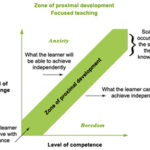Puzzles and the Zone of Proximal Development
When I teach about Lev Vygotsky and his renowned theory of the “Zone of Proximal Development” I use puzzles as means of illustrating the principles in an understandable way. Remember this…
As adults or more competent peers support a child’s learning, the child moves from one level in which he can complete tasks independently to the next. This process is called, “scaffolding.”
Take a look at this video of a teacher and another boy supporting a child as he attempts to complete a puzzle.
Did you see the friend show him how to move the pieces around so they fit? Listen as the teacher reminds him that the piece he is holding is a corner piece. Both of these are examples of how an adult or a more sophisticated peer can provide just enough information to a child so that the learning is scaffolded.
Now watch the child complete the puzzle completely in his own. Notice the spatial knowledge required to do so.
